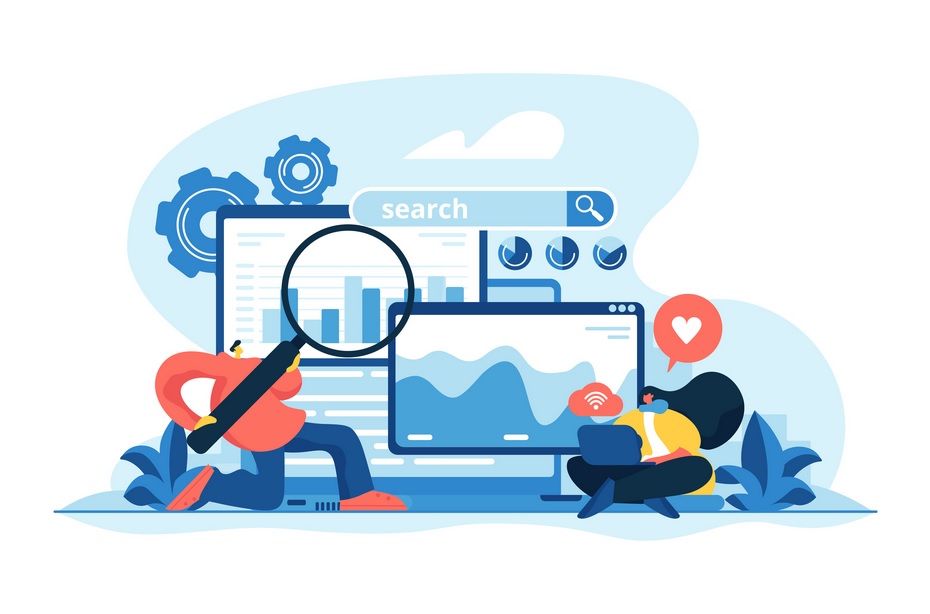
A majority of consumers’ time is spent online, whether it’s looking for information on search engines or scrolling through their social media feeds. For this reason, it makes a lot of sense for businesses to reach their target audience through digital platforms.
Search engines, in particular, are useful in introducing your brand to people who are interested in your products and services. You can optimize your website for these platforms through SEO.
What is SEO?
Search engine optimization (SEO) is a digital marketing technique that entails enhancing certain elements of your site. If you do this well, search engine bots will crawl through your web pages and add them to their indexes. Your content can then be delivered to your target audience for relevant queries.
 Google and Bing utilize keywords and links for their rankings. The former is used by search bots to understand the content of your pages, while the latter is valuable for these crawlers to explore millions of sites in the World Wide Web.
Google and Bing utilize keywords and links for their rankings. The former is used by search bots to understand the content of your pages, while the latter is valuable for these crawlers to explore millions of sites in the World Wide Web.
While these components are useful for evaluating the quality of your website, there are actually hundreds of ranking signals. Google and Bing want to make sure that they only deliver accurate and relevant content to web users’ queries in the search engine results pages (SERPs). This may also be the reason why they keep the exact workings of their algorithms a secret.
Knowing this, business owners should plan out a solid SEO strategy based on white hat or legitimate tactics to improve their site’s traffic. Use a website traffic checker to monitor the number of web visitors that you garner regularly. The tool can give insights on areas in your domain that are effective in attracting and converting leads, as well as those that need improvement.
This SEO course in Singapore will help you learn what SEO is, the basics of optimising your website such that it will enhance your site’s search rank and performance, and how to use tools to conduct competitor benchmarking.
Different Facets of SEO
Since SEO involves optimizing all elements of your website, it has several subcategories. Each one plays a significant role in making a successful digital marketing campaign.
Here are the different types of SEO:
1. Technical
Technical SEO checks the back-end of your website, which is the section that’s only visible to Google and Bing. The primary objective with this type of SEO is to ensure that search engine bots can crawl and index your site with ease.
One of the main factors that technical SEO focuses on is your robots.txt. This file is located in your website’s root directory. It contains instructions for search engines regarding the pages that the bots should crawl and index.
During the crawling and indexing process, search bots look for the robots.txt file once they land in your domain. Depending on what you write in this document, the crawlers will make a list of the URLs that they can crawl through and add in their databases.
If you don’t have a robots.txt file, the bots will assume that all publicly available pages in your site should be crawled and added to their index. You should format the document appropriately to avoid any technical issues.
2. On-Page
On the other hand, on-page SEO focuses on the elements of the site which web visitors can see. This involves the content, and the keywords like NIIN Zero Tobacco Pouches that people use in their search queries.
These are the factors that you should optimize for on-page SEO:
- Page Title – The page title or headline of your content must be interesting enough, since these are displayed prominently in the SERPs for queries that contain your target keywords. It should encourage web visitors to click on your link.
- Headers – The biggest no-no in content creation is to paste a huge block of text onto your website and leave people to decode the message by themselves. However, if you break your blog post into sections to make it more readable and appeal to the eyes of web visitors, you will also appeal to SEO bots.
The top of their website clearly outlines key content pillars: services, industries, insights, and careers. - Images – Search bots don’t see and comprehend pictures in the same way as humans. Because of this, you should take advantage of alt attributes to inform these machines of what the images are all about. Incorporate your target keywords in these alt attributes, and even filename to supplement your SEO.
- Formatting – While search bots can’t judge the aesthetics of your blog post, they do know whether your page is filled with ads and popups that can hamper the experience of users in your domain. As mentioned above, huge blocks of texts are also unappealing and can damage your SEO and credibility.
There’s intense competition for the attention of web users. You need to stay on top of your on-page SEO campaign by using a keyword difficulty tool. This checker analyzes the viability of your target keywords, and gives you insights into how many others are competing for the same search terms.
3. Off-Page
While the first two types of SEO revolve around the elements in your domain, off-page SEO pertains to how you promote your content online. This way, you can direct more traffic into your site.
Link building is a well-known off-page SEO method. It entails acquiring backlinks, which are links from third-party websites that bring people into your domain. These are considered as stamps of approval on your content. Having multiple backlinks from high-authority sources implies that your blog is a credible source of industry information and, thus, deserves a favorable spot in the SERPs for relevant queries.
You must remember, though, that not all backlinks weigh the same. Those from websites that have already established their reputation in your niche give more link juice than the ones from unknown and young sites.
4. Local
You have to approach SEO with specificity. As stated earlier, there’s intense competition in the SERPs for broad keywords, especially those comprising of one or two words only. You have to focus on local SEO if you want to narrow down your target audience and get a higher chance of digital marketing success.
Local SEO is the process of optimizing your website for queries in your target location. It’s ideal for businesses that have a physical store, to bring in more customers.
Nonetheless, it’s useful for all brands, since it allows you to focus on consumers in the same country or state and build a following.
Google My Business is an excellent platform for local SEO. This feature was created to help companies to provide first-hand information to their customers, especially regarding their name, address, and phone number (NAP). There’s also a reviews section for people to share their experience with your brand.
5. Mobile
Most consumers are tethered to their smartphones these days, so it makes a lot of sense for business owners to meet them at their favorite platforms. Click here to learn more on how impactful is social media in China. Mobile SEO is all about optimizing your website so that it looks good no matter what screen size, operating system or orientation your visitors are viewing from. It’s an integral part of user experience (UX).
Employing a responsive web design is an excellent tactic. With this tool, you don’t have to develop several codes for different devices. Your website will adapt to the receiving environment and display your site elements accordingly.
Benefits of SEO for Your Business in 2021
SEO is crucial for the success of your business, in 2021 and beyond. You should ramp up your digital marketing efforts to bring more potential customers into your domain.
The following are some benefits that your business can reap with a solid SEO campaign:
1. Boost Brand Visibility
It can be challenging to make your brand known in today’s competitive world. That’s why you need all the help you can get. SEO is a valuable tool, in that it allows small businesses to carve their own niche in the market with the right strategies.
This digital marketing technique won’t make your brand a household name overnight, though. You still have to put the work in, by producing top-quality content consistently. This way, you’ll be noticed by high-authority sites in your industry and earn backlinks from them, which can boost your rank in the SERPs and increase your visibility to your target audience.
2. Improve User Experience
More than providing relevant and accurate content to web users, you also have to make sure that you’re delivering information in an appealing package. Search engines value the experience that users have on your website, and use it to determine whether your domain deserves to be on the first page of the SERPs.
For instance, if you have a slow-loading site, people will most likely abandon it within the first few seconds and look for another one. This implies that you aren’t delivering high-quality service to web users, which will affect your rank.
Having a strong UX can improve your site’s SEO success because it helps you move up in the SERPs. Because of this you must ensure to check your website’s performance in this area regularly. View site here to check the website new look and feel.
These are the key elements of UX design:
- Organized Architecture – The structure of your website must be logical and intuitive for users. Web visitors must understand how to navigate to their desired content and explore the pages in your domain with ease.
- Interactive Design – People must be able to interact with the elements on your website as naturally as possible. Words, visual presentation, touchpoints and response to the users’ actions all work together to provide a seamless experience for potential customers.
- Usability – Usability pertains to how easily users can achieve their end goal without being confused by other elements of your website. Popups, while useful for informing new visitors of your promos, can deter them from viewing the content that they want to watch. You should be careful about putting too many distracting components or, worse, putting off your target audience.
- Visual Appeal – The proper use of layouts, spacing, images, videos and color can enhance the experience of your visitors. It’s better to lean toward a minimalist design, though, as a flashy website can confuse web users in their navigation of your domain..
- User-Based Improvements – Excellent UX design begins and ends with the users in mind. Make sure that you get to know the browsing habits, preferences and objectives of your target audience so that you can make personalized enhancements.
3. Acquire More Leads
Digital marketing is still a numbers game. The more visible that your website is to your target audience, the better chance it will have of gaining leads. These leads have the highest potential to turn into paying customers, so make sure that you nurture them.
A few lead generation tips to help you acquire more leads:
- Make Forms Accessible – Forms are the main tools for getting web visitors’ information. You should make them accessible to people. You should add them wherever it’s feasible to do so, so that visitors will always have one on-hand at the right stage in their buying journey.
- Ask for Minimal Information – Nonetheless, you should also be mindful of the data that you’re asking from potential customers. You must ensure that you’re only getting the necessary details that you’ll be using for future transactions. Usually, asking for people’s contact information is enough to nurture your relationship with them.
- Maximize White Space – Also called negative space, white space can emphasize the message of your call-to-action (CTA). The typical instinct might be to fill up every area of your web page with information. However, this is confusing and off-putting. Utilize white space to direct people’s eyes to the content that you want them to read.
4. Increase Conversions
Most business owners think that conversions refer to the number of people who purchase their products and services on their site. However, the term actually pertains to those who completed a desired action. This can include filling up a form and becoming a lead, or signing up for your newsletters.
Again, SEO can help you to increase conversions, since it boosts your visibility to people who use your keywords in their queries. They’re the ones who’ve already expressed interest in your niche, and are most likely to become customers.
Conclusion
SEO is a valuable tool for boosting your brand’s online presence, which allows you to reach your target audience and increase conversions. It helps your business by introducing your company to people who might be interested in your products and services, and encouraging them to take this interest further.
You may also like:- Why Proxy-Sale.com is the Right Choice for Your Proxy Needs
- ASPICE-Compliant Software Development: Ensuring Quality in the Automotive Industry
- Tips for Picking the Best Software Development Partner
- PAFI SUMEDANG UTARA : Making Achievements and Contributions in the Health Sector
- Reactive Dog Trainer in Denver: Preventive Approach to Reactivity
- Floki Crypto Explained: Everything You Need to Know Before Investing
- Top Key Features of Snaptik You Need To Know
- The Importance Of Having Proper Hearing Aids
- Impact of Energy Efficiency on Solar Power Systems Calculations
- Maxim Krippa bought the first gold medal of the CS: GO team









